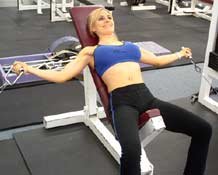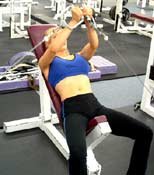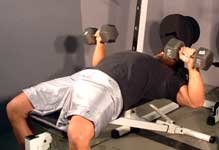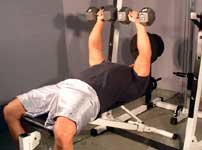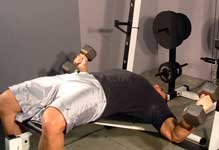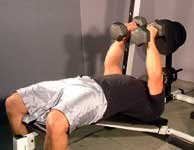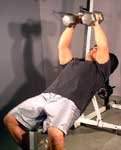Strip away the layers of striated muscle draped over massive IFBB pros such as Silvio Samuel and what you'll notice is that the size of his actual muscle fibers due to protein content really aren't that much larger than your own.
Muscle fiber size has been investigated in research studies that compared the muscle composition of elite bodybuilders and athletes with that of regular, healthy individuals.
Despite having larger muscle circumference measurements, the actual size of the bodybuilder's and athlete's individual muscle fibers were not significantly different than that of the regular groups.
This and other research suggests that the freaky muscle size witnessed in bodybuilders is the result of complex structural and chemical adaptations that occur in response to resistance training beyond that of muscle fiber hypertrophy of the contractile elements actin and myosin.2,3
This is promising news to bodybuilders of all levels and means that there is more than one way to increase muscle size. After all, we haven't all been blessed with the same number of muscle fibers that many competitive bodybuilders were dealt at birth.
In many cases, we don't have the same raw materials to build massive muscles from. But there is a solution. Working with your body's physiology you can customize your training program to take advantage of fluid dynamics, exploiting an alternative pathway to increasing muscle size—increasing muscle cellular volumization.
Cumulative Blood Volume Training (CBVT)
During a workout, blood flow is routed to the muscle being trained. Packed into the plasma component of the blood is a rich supply of cell-volumizing compounds such as amino acids, creatine, glucose, minerals, electrolytes and anabolic hormones.
The goal of Cumulative Blood Volume Training (CBVT) is to flood the muscle being trained with as much blood as humanly possible. Sometimes, this means forgetting about how much weight your lifting or whether you're breaking your personal bests.
The only thing that should be going through your head is to force as much blood into the targeted area via ultra-focused muscular contractions. This will amplify the delivery of cell-hydrating compounds directly into the muscle where they will be transported into the tiny cellular compartments of muscle fibers producing an enlarged, "hyper-hydrated" state.
CBVT is not accomplished in just a few sets and reps. It's called "cumulative" for a reason. Rather than think of each individual exercise, set, rep and weight being used, you'll have to think of the entire workout as one massive, cumulative signal being delivered to a targeted area.
It could take up to 16-20 sets for larger muscle groups and 12-15 sets for smaller muscle groups to completely fill the area with blood and generate a powerful anabolic signal in the muscle.
Any training method that works to increase the delivery of blood to the muscle is acceptable in a CBVT routine. According to some experienced bodybuilders, incorporating techniques such as 2-4 second peak contractions and 10-second static contractions worked into your routine can help to prevent blood flow and allow metabolites to build up.
Once the "temporary blockage" is removed, a large surge of blood is triggered to the area to remove the metabolites. This method of temporarily disrupting normal blood flow can work to create a powerful rush of anabolic-rich blood to the targeted area.
Rest in between sets should be kept to less than one minute. Too much time in between sets can cause you to lose your pump and take away from the overall goal of CBVT. Rest intervals of 45 seconds are optimal to keep a steady flow of nutrients constantly filtering into muscle cells with repeated contractions.
Preventing Excessive Sarcolemmic Disruption
The muscle cell membrane is a highly complex, interactive structure. Also referred to as the sarcolemma, this phospholipid bi-layer acts as a gatekeeper to control what can enter and leave the muscle cell.
The sarcolemma uses transporters to get molecules into and out of the muscle cell. To maximize the intracellular contents of muscle cells, it is crucial to maintain the structural integrity of the sarcolemma.
When the structural integrity of the sarcolemma is compromised, cellular contents can leak out of the muscle cell and potentially reduce overall muscle volume and size. Training to increase muscle cell volume should then be tweaked to prevent excessive sarcolemmic disruption.
Some research has found that stressing eccentric contractions (lengthening of the muscle) can result in a higher amount of myofibrillar damage, and muscle membrane disruption.4,5,6
These contractions are an essential tool in producing muscle gains via adaptive myofibrillar hypertrophy. However, in excess, it is this same microscopic damage that causes eccentric contractions to interfere with maximizing muscle cell volume.
The key is balance. If you've been focusing on eccentric contractions in every workout without seeing much of a hypertrophic response in muscle size, maybe it's time to switch up your training to minimize the eccentric portion of your lifts.
Modify your training to become almost rhythmic; move the weight through a controlled path while maintaining strict tension on the muscle throughout the entire set, using a velocity of one to two seconds for the concentric and one second for the eccentric. Reps should be kept in the 12-15 rep range to maximize blood flow and nutrient delivery while preventing excessive muscle cell membrane disruption.
Glycogen Supercompensation
Muscle cells have a high storage capacity for glycogen. This provides an immediately available source of energy to fuel intense training sessions. When intramuscular glycogen levels are topped off, muscle density is at its peak and muscles are harder and fuller. This is in part due to an increased plasma component in the muscle cell that accompanies glycogen in a 3:1 ratio.
When muscle glycogen levels are filled beyond a previously set threshold, glycogen "supercompensation" is achieved. Researchers have determined that glycogen supercompensation can be achieved via a 3-day exercise and low-carbohydrate phase, followed by a 3-day rest and high-carb phase.

 Click Image To Enlarge.
Click Image To Enlarge. Glycogen Supercompensation Is Achieved When
Glycogen Levels Are Filled Beyond Their Threshold.
The second component to achieve a supercompensated state in muscle is to only emphasize concentric contractions, which do not disrupt glycogen synthase activity and GLUT-4 receptors—two mechanisms that are both required for optimal glycogen synthesis. This loading process can be further enhanced by taking in a large dose of high glycemic carbohydrates in the post-workout period, when muscle cells have been primed for an influx of glucose.
Maximum Expansion Chest Program
To help put these elements into a plan of action for you, here is a sample chest routine that focuses on and maximizes muscle cell volume.
Incline Cable Flyes: 4 x 12-15
Bring an incline bench over to the cable cross-over station in your gym. With every rep, be sure to get a full range of motion and a two second peak contraction at the top of the rep. Keep your shoulders pinned back against the bench during the set to help maximize chest recruitment.
Flat Dumbbell Press/Fly: 4 x 12-15
Select a weight that's about 20 percent lighter than what you would normally use on a flat dumbbell press. Start the lift as you would normally perform a dumbbell press, but at the 3/4 position of the rep start turning the dumbbells inward so that your palms are facing each other at the top.
Keep tension on the chest by keeping the weight constantly moving throughout the entire set and add in a few partial reps at the end where you're only doing the fly portion of the rep.
Decline Dumbbell Flyes: 4 x 15-20
Set up a decline bench and choose a weight that you can manage 15 reps with strict form. Use a wide pathway to maximize the tension on the muscle.
As you bring the weight up, straighten your arms and think about bringing your elbows together. With every rep, visualize blood being forced into the chest.
Incline Hammer Strength Press: 4 x 12-20
Finish off the chest with four sets of a incline hammer strength press with an emphasis on the concentric phase of the rep to help deplete glycogen and support supercompensation. Use a rep velocity of one second per rep phase and keep your shoulders down and back throughout.
References:
- MacDougall, J.D., D.G. Sale, J.R. Moroz, G.C.B. Elder, J.r. Sutton, and H.Howard. Muscle ultra-structural characteristics of lite power-lifters and bodybuilders. Eur. Journal Appl. Physiol. 48:117-126. 1982.
- Goforth H.W. et al. Persistence of supercompensated muscle glycogen in trained subjects after carbohydrate loading. Journal of Appl Physiol. Vol. 82. (1) 342-347. 1997.
- Yamada, S., N. Buffinger, J. Dimario, and R. C. Strohman. Fibroblast growth factor is stored in fiber extracellular matrix and plays a role in regulating muscle hypertrophy. Med. Sci. Sports Exerc. 21(5): S173-S180, 1989.
- D.L. Morgan and D.G. Allen. Early events in stretch-induced muscle damage. Journal Appl Physio. 87: 2007-20015, 1999.
- Clarkson P.M, Tremblay I. Exercise-induced muscle damage, repair and adaptation in humans. Journal of Applied Physiol. Vol 65, (1) 1-6. 1988.
- Hortobagyi, T. et al. Normal forces and myofibrillar disruption after repeated eccentric exercise. Journal Appl Physiol. (84): 492-498, 1998.



